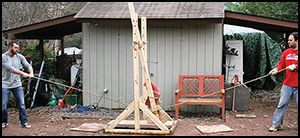Article contents
Experimental stone-cutting with the Mycenaean pendulum saw
Published online by Cambridge University Press: 09 February 2018
Abstract

The development of an advanced stone-working technology in the Aegean Bronze Age is suggested by the putative Mycenaean pendulum saw. This device seems to have been used to cut through hard sedimentary rock at a number of sites on the Greek mainland and, according to some scholars, also in central Anatolia. As no pendulum saws are preserved in the archaeological record, understanding the machine relies on preserved tool marks and experimental research. This paper presents the results of stone-cutting experiments conducted with a modern reconstruction of a pendulum saw. The research investigates blade shape, size, design and the mechanics of the device, while questioning the accuracy of earlier reconstructions.
- Type
- Method
- Information
- Copyright
- Copyright © Antiquity Publications Ltd, 2018
References
- 3
- Cited by




